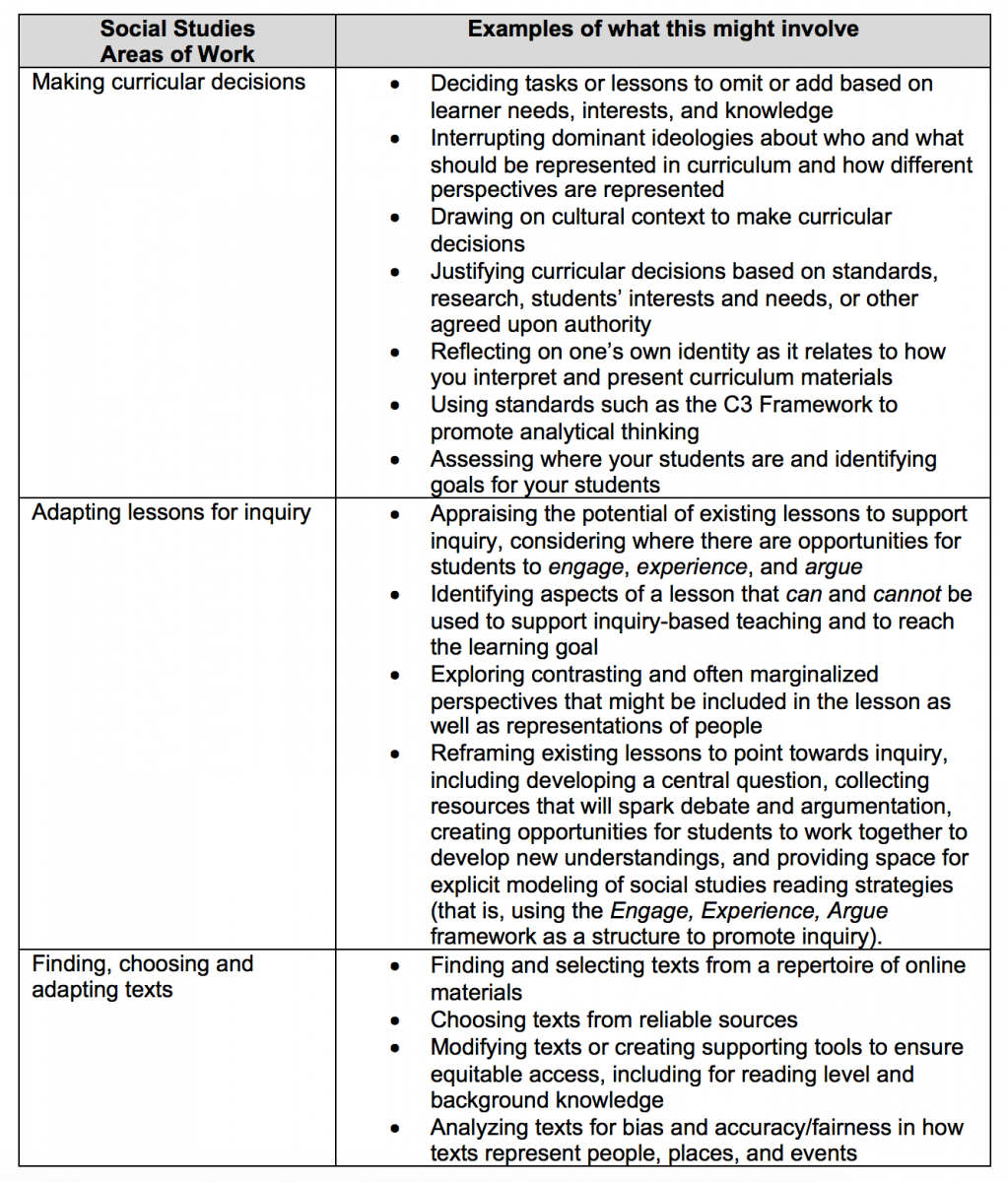What is designing lessons and adapting curricular resources for social studies?
Choosing and adapting curriculum materials involves finding, selecting, assessing, and revising curriculum materials so that they work for the students teachers work with and for the teacher’s goals for a lesson. This process might occur at multiple levels. First, teachers might assess the arc of a unit of instruction, making judgments about what lessons or multi-day studies to include or omit. Teachers might also look at the lesson level, reinventing individual lessons to promote inquiry. Even more specifically, teachers who adapt curriculum resources proficiently examine the sources that students use, making sure they are appropriate for the grade level, relevant to the learning goals and compelling questions under investigation, and diverse in perspective.
Advancing justice
Choosing and adapting curriculum materials is essential to providing students with equitable access to higher order thinking and learning experiences that provoke curiosity. Students who have not traditionally been well served in school are more likely to receive rote instruction disconnected from their lived experiences, while students in wealthier schools may be provided with curriculum that encourages them to explore and make sense of the world. The ability to adapt curriculum resources can narrow the curricular opportunity gap that exists in U.S. schools and that results in different levels of rigor and challenge for students.
Choosing and adapting curriculum materials can also help teachers interrupt dominant narratives that are reinforced through the curriculum. By virtue of inclusion in textbooks and official histories, some narratives gain more power and authority than others. In order to disrupt this power disequilibrium, teachers must be able to identify perspectives that are included and overlooked in lesson plans and textbooks, and find sources that highlight the roles of diverse populations and challenge conventional or incomplete representations of diverse people.
Finally, choosing and adapting curriculum materials is a key opportunity to highlight difference and diversity in the school community and wider world. Teachers will want to draw on the resources of the students they teach and provide resources that relate to their histories and to the histories of people unlike themselves. Teachers must also learn to attend to diversity in mono-cultural schools where difference and diversity can be masked.
Why work on designing lessons and adapting curricular resources in social studies?
For decades, educational researchers have documented how textbook-based instruction has dominated teaching and learning in social studies. Scholarly literature also notes how textbooks marginalize many perspectives in history in favor of a single narrative. These narratives often highlight nation building and progress while leaving little room for students to think critically about sources, reason, and develop their own theories about our past.
At the same time, obstacles to reinventing social studies curriculum are numerous. Teachers of social studies often have few curricular resources outside of textbooks and materials that are free online. Teachers may be required to use particular curricula or cover particular topics, as social studies curriculum is highly politicized. Finally, beginning teachers have too much to do, and developing new curricula takes extensive amounts of time.
Based on our observations of successful beginning teachers, the ability to choose and adapt existing curricular resources, rather than entirely reinvent them, is the most high-leverage means of providing students with routine access to curriculum that promotes critical thinking and investigation of compelling historical and social problems.
Decomposition
The graphic below represents our latest thinking on choosing and adapting curriculum materials in history-social science. The headings in the left-hand column represent three levels of thinking, starting at the unit level (making curricular decisions), narrowing to adapting lessons, and moving even smaller still to working with individual texts. We recognize that this decomposition is similar but not identical to the TeachingWorks decomposition meant to represent multiple subject areas. We maintain that the differences between these decompositions stem from unique aspects of the disciplines, such as the centrality of investigating text to the discipline of history.

Supporting novice teachers
Over the course of working on choosing and adapting curriculum materials with novice teachers, we have found that a number of forces dictate how novice teachers choose and adapt curriculum materials. These forces include the disciplinary understanding of the novice teacher, social identities of the novice teacher, social justice commitments of the novice teacher, student teaching school context, mentor teacher, existing curriculum materials, and more. We have found that exposing these forces and discussing them in our methods course have made our novices more successful at trying out this practice.
Novices tend to have difficulty in coordinating the key parts of a lesson that structure inquiry in social studies. For example, selecting and creating a good text set (or set of sources) to ground the inquiry is challenging, as is defining a compelling central question that opens a space for inquiry while being aligned with the sources and clear or interesting to students. Looking at examples of strong curriculum (see Activity 5) and practice in choosing and adapting curriculum with feedback support novices’ learning.